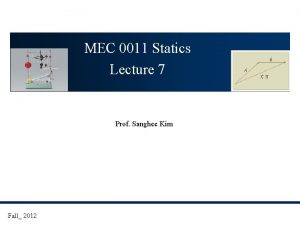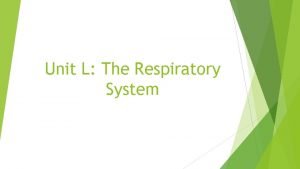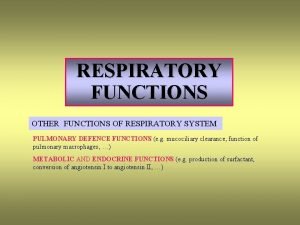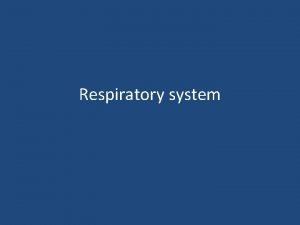RESPIRATORY SYSTEM RESPIRATORY FUNCTIONS MECHANICS OF RESPIRATORY SYSTEM








![LUNG VOLUMES INSPIRATORY RESERVE VOLUME maximal inspiratory level [l ] IRV ~2. 5 end LUNG VOLUMES INSPIRATORY RESERVE VOLUME maximal inspiratory level [l ] IRV ~2. 5 end](https://slidetodoc.com/presentation_image_h/0566adc7f33eb404110b79f75761c2ff/image-9.jpg)

- Slides: 10

RESPIRATORY SYSTEM RESPIRATORY FUNCTIONS MECHANICS OF RESPIRATORY SYSTEM GAS TRANSPORT Author of presentation: doc. MUDr. Milena Šimurdová, CSc.

STEPS IN THE DELIVERY OF O 2 TO THE CELLS airways VENTILATION OF THE LUNGS DIFFUSION OF O 2 ACROSS ALVEOLAR-CAPILLARY MEMBRANE DIFFUSION OF O 2 FROM CAPILLARY TO THE CELLS AT REST alveoli alveolar-capillary m. capillary TRANSPORT OF O 2 IN THE BLOOD O 2 UPTAKE ~300 ml / min UTILIZATION OF O 2 BY MITOCHONDRIA CO 2 OUTPUT ~250 ml / min INTERNAL RESPIRATION 1

AIR PASSAGES ANATOMICAL DEAD SPACE –CONDUCTING ZONE NASAL PASSAGES PHARYNX Other physiological functions: LARYNX air is warmed, cleaned and takes up water vapour respiratory reflex responses to the irritants TRACHEA speech and singing (function of larynx) BRONCHIOLES TERMINAL BRONCHIOLES RESPIRATORY ZONE (GAS EXCHANGE) Total alveolar area ~100 m 2 2

CAST OF HUMAN AIR PASSAGES TRACHEA BRONCHIOLES TERMINAL BRONCHIOLES AERODYNAMIC RESISTENCE 3

ciliated cylindrical epithelium mucus lamina propria AUTONOMIC INNERVATION of smooth muscle cells visceral pleura Muscarinic receptors: Acetylcholine activates bronchoconstriction smooth muscle cells gland cartilage -adrenergic receptors: Noradrenaline activates bronchodilatation goblet cell blood vessels BRONCHUS TERMINAL BRONCHIOLE < 1 mm 4

VT tidal volume VT = VA + VD ~ 500 ml VA part of tidal volume entering alveoli ~ 350 ml VD part of tidal volume remaining in the dead space ~ 150 ml f = 12/min ∙ V = VT x f PULMONARY MINUTE VENTILATION 6 l/min · VA = VA x f ALVEOLAR VENTILATION 4. 2 l/min · VD = VD x f DEAD SPACE VENTILATION 1. 8 l/min 5

DEAD SPACE TOTAL GAS VOLUME NOT EQUILIBRATED WITH BLOOD (without exchange of gasses) ANATOMICAL dead space - volume of air passages FUNCTIONAL (total) dead space ANATOMICAL dead space + total VOLUME of ALVEOLI without functional capillary bed IN HEALTHY INDIVIDUALS both spaces are practically identical 6

SPIROMETRY (measurements of lung volumes, capacities, functional investigations, …) inverted bell inspiration water seal expiration subject 7
![LUNG VOLUMES INSPIRATORY RESERVE VOLUME maximal inspiratory level l IRV 2 5 end LUNG VOLUMES INSPIRATORY RESERVE VOLUME maximal inspiratory level [l ] IRV ~2. 5 end](https://slidetodoc.com/presentation_image_h/0566adc7f33eb404110b79f75761c2ff/image-9.jpg)
LUNG VOLUMES INSPIRATORY RESERVE VOLUME maximal inspiratory level [l ] IRV ~2. 5 end of quiet inspiration TIDAL VOLUME VT EXPIRATORY RESERVE VOLUME ERV He RV ~1. 7 maximal expiratory level ~1. 3 RESIDUAL VOLUME RV DILUTION METHOD end of quiet expiration Principle of method: 1 Maximal expiration, 2 Repeated inspiration from and expiration into a reservoir (known volume Vr) with inert gas He (known concentration ci) Equilibration of the air in the residual volume and reservoir He ci reservoir (Vr) 3 Calculation of residual volume RV from the initial and final He concentrations in reservoir (ci , cf). RV He cf reservoir (V) 8

maximal inspiratory level TLC INSPIRATORY CAPACITY VC >3. 0 l end of quiet expiration RV VC maximal expiratory level ~1. 2 l VITAL CAPACITY FUNCTIONAL RESIDUAL CAPACITY <3. 0 l = VT + IRV + ERV ~ 4. 7 l VC - the largest amount of air that can be expired after maximal inspiration TLC TOTAL LUNG CAPACITY = VC + RV ~ 6. 0 l 9
 Respiratory zone vs conducting zone
Respiratory zone vs conducting zone The upper airways
The upper airways Digestive system respiratory system and circulatory system
Digestive system respiratory system and circulatory system Tiny air sacs at the end of the bronchioles
Tiny air sacs at the end of the bronchioles Circulatory system and respiratory system work together
Circulatory system and respiratory system work together Absolute value as a piecewise function
Absolute value as a piecewise function Evaluating functions and operations on functions
Evaluating functions and operations on functions Evaluating functions and operations on functions
Evaluating functions and operations on functions Concurrent force system
Concurrent force system Statics
Statics Respiratory system bozeman
Respiratory system bozeman



















